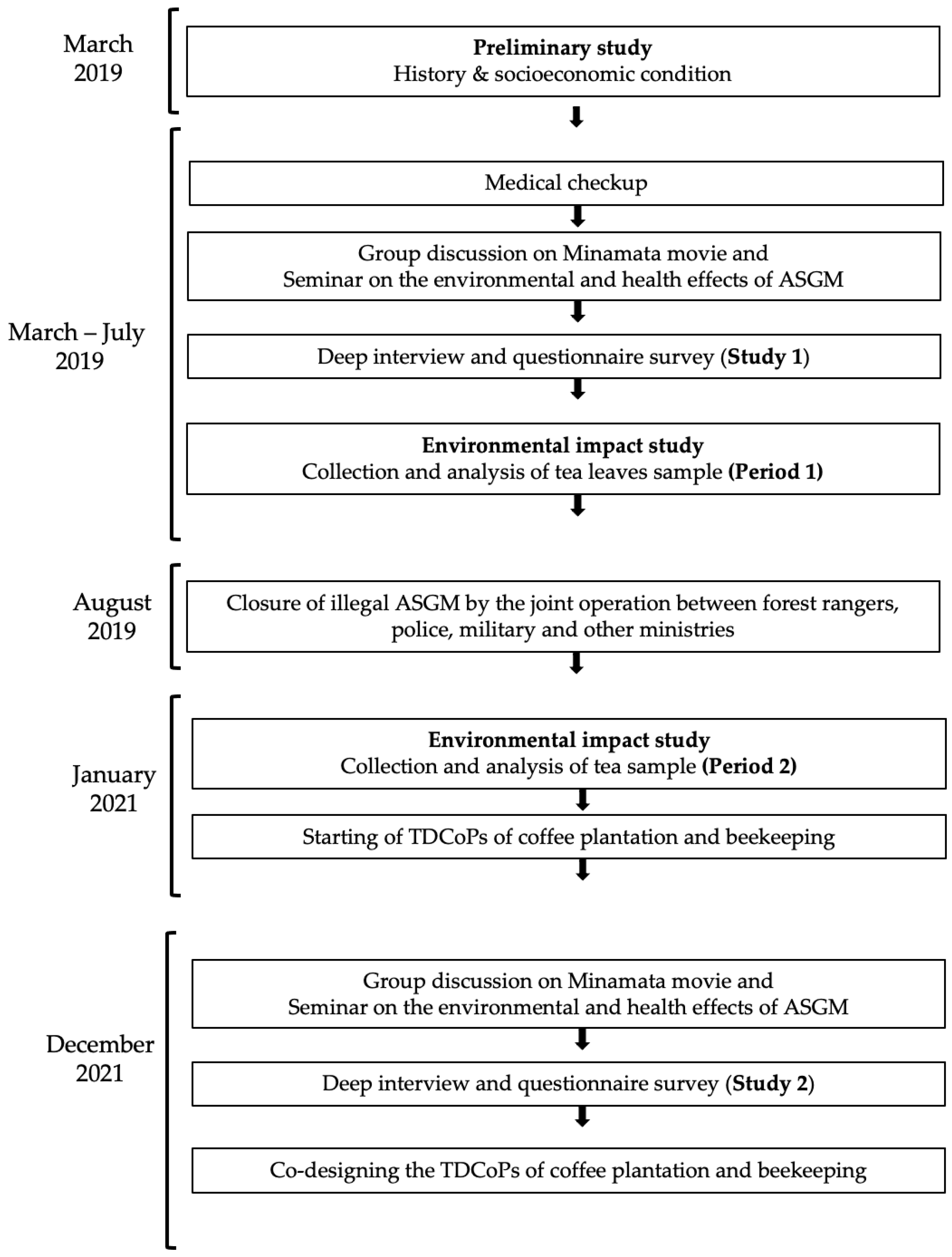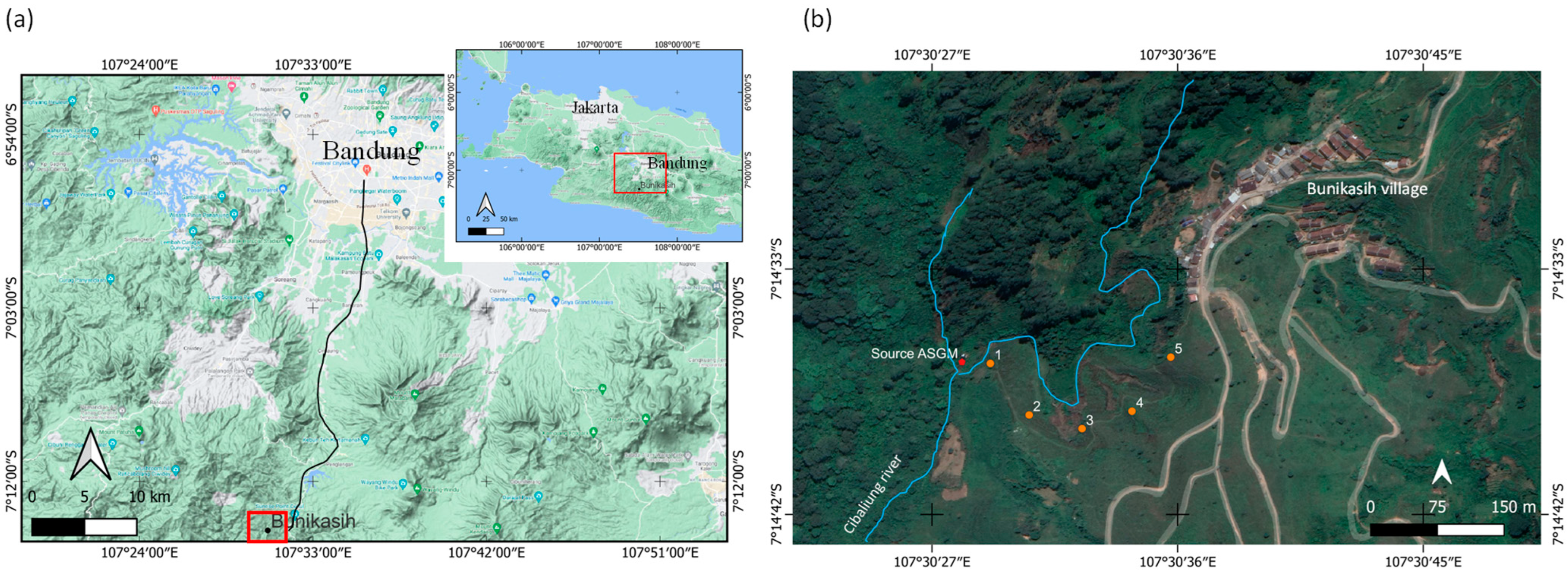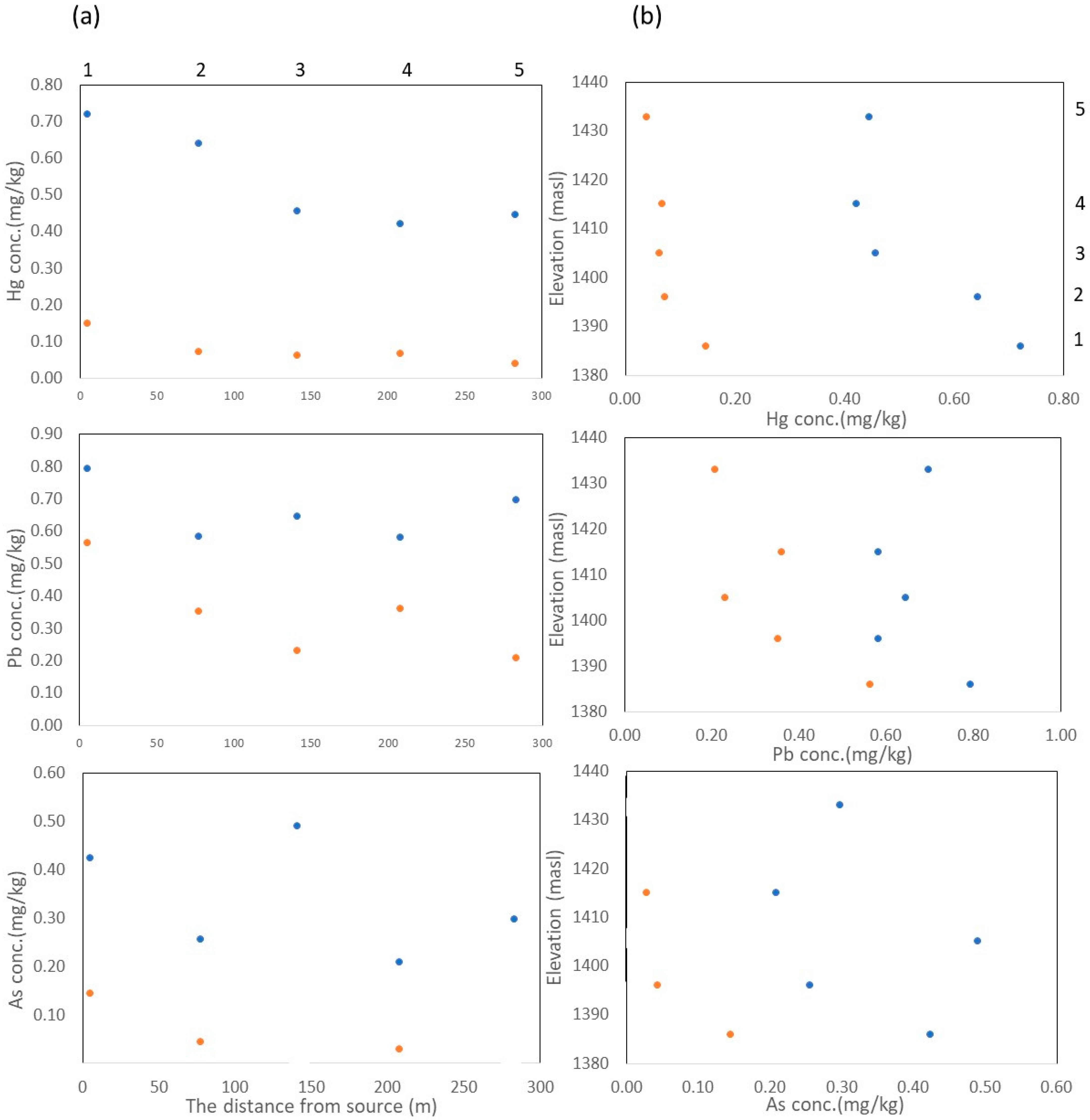Change in Values of Illegal Miners and Inhabitants and Reduction in Environmental Pollution after the Cessation of Artisanal and Small-Scale Gold Mining: A Case of Bunikasih, Indonesia
Abstract
1. Introduction
1.1. Artisanal and Small-Scale Gold Mining (ASGM) in Indonesia
1.2. Interventions for the Elimination of Hg from ASGM and Perception of Miners
1.3. Transdisciplinary Research Practice to Tackle ASGM Issues
1.4. Preliminary Transdisciplinary Study at the Study Site
2. Materials and Methods
2.1. Questionnaire Survey and Deep Interview
2.1.1. Seminar on the Environmental and Health Effects of ASGM
2.1.2. Small Group Discussion
2.1.3. Deep Interview
2.1.4. Questionnaire Survey
2.2. Environmental Impact Study
2.2.1. Location
2.2.2. Sampling Methods
2.2.3. Analysis
3. Results
3.1. Medical Checkup
3.2. Questionnaire Survey and Deep Interview
3.2.1. Change in Respondents’ Values
3.2.2. Closure of Illegal ASGM
3.2.3. Process of Transdisciplinary Community of Practice (TDCoP) to Form Alternative Livelihoods
3.3. Environmental Impact Study
4. Discussion
4.1. Changes in Values of Illegal Miners and the Formation of Transdisciplinary Community of Practice
4.2. Environmental Impact Assessment: Correlation to Distance, Elevation, and Sources of Pollution
4.3. Contamination Level and Environmental Assessment of ASGM Activity Closure
4.4. Limitation
5. Conclusions
Author Contributions
Funding
Institutional Review Board Statement
Informed Consent Statement
Data Availability Statement
Acknowledgments
Conflicts of Interest
References
- WHO (World Health Organization). Exposure to mercury: A major public health concern. Prev. Dis. Through Health Environ. 2006, 4, 4. [Google Scholar]
- Siegel, S.; Veiga, M.M. Artisanal and small-scale mining as an extralegal economy: De soto and the redefinition of “formalization”. Resour. Policy 2009, 34, 51–56. [Google Scholar] [CrossRef]
- Vareda, J.P.; Valente, A.J.M.; Durães, L. Assessment of heavy metal pollution from anthropogenic activities and remediation strategies: A review. J. Environ. Manag. 2019, 246, 101–118. [Google Scholar] [CrossRef]
- Gafur, N.A.; Sakakibara, M.; Komatsu, S.; Sano, S.; Sera, K. Environmental Survey of the distribution and metal contents of pteris vittata in arsenic-lead-mercury-contaminated gold mining areas along the Bone River in Gorontalo Province, Indonesia. Int. J. Environ. Res. Public Health 2022, 19, 530. [Google Scholar] [CrossRef] [PubMed]
- Rakete, S.; Moonga, G.; Wahl, A.M.; Mambrey, V.; Shoko, D.; Moyo, D.; Muteti-Fana, S.; Tobollik, M.; Steckling-Muschack, N.; Bose-O’Reilly, S. Biomonitoring of arsenic, cadmium and lead in two artisanal and small-scale gold mining areas in Zimbabwe. Environ. Sci. Pollut. Res. Int. 2022, 29, 4762–4768. [Google Scholar] [CrossRef]
- Rivera-Parra, J.L.; Beate, B.; Diaz, X.; Ochoa, M.B. Artisanal and small gold mining and petroleum production as potential sources of heavy metal contamination in Ecuador: A call to action. Int. J. Environ. Res. Public Health 2021, 18, 2794. [Google Scholar] [CrossRef] [PubMed]
- Kania, D.; Ismawati, Y. Inventory of mercury releases in Indonesia. In Proceedings of the 5th Environmental Technology and Management Conference “Green Technology towards Sustainable Environment”, Bandung, Indonesia, 23–24 November 2015. [Google Scholar]
- Ban Toxics. The Price of Gold: Mercury Use and Current Issues Surrounding Artisanal and Small-Scale Gold Mining in the Philippines; Ban Toxics: Quezon City, Philippines, 2010. [Google Scholar]
- Yoshimura, A.; Suemasu, K.; Veiga, M.M. Estimation of mercury losses and gold production by artisanal and small-scale gold mining (ASGM). J. Sustain. Metall. 2021, 7, 1045–1059. [Google Scholar] [CrossRef]
- Veiga, M.M.; Angeloci, G.; Hitch, M.; Colon Velasquez-Lopez, P. Processing centres in artisanal gold mining. J. Clean. Prod. 2014, 64, 535–544. [Google Scholar] [CrossRef]
- García, O.; Veiga, M.M.; Cordy, P.; Suescún, O.E.; Molina, J.M.; Roeser, M. Artisanal gold mining in Antioquia, Colombia: A successful case of mercury reduction. J. Clean. Prod. 2015, 90, 244–252. [Google Scholar] [CrossRef]
- McGrew, L. Artisanal and Small Scale Gold Mining: A Sector of Problems and a Sector of Promise. Available online: https://www.asiapacific.ca/blog/artisanal-and-small-scale-gold-mining-sector-problems-and (accessed on 22 June 2023).
- Esdaile, L.J.; Chalker, J.M. The mercury problem in artisanal and small-scale gold mining. Chem. A Eur. J. 2018, 24, 6905–6916. [Google Scholar] [CrossRef]
- Basri; Sakakibara, M.; Sera, K. Mercury in soil and forage plants from artisanal and small-scale gold mining in the Bombana Area, Indonesia. Toxics 2020, 8, 15. [Google Scholar] [CrossRef] [PubMed]
- Meutia, A.A.; Lumowa, R.; Sakakibara, M. Indonesian artisanal and small-scale gold mining—A narrative literature review. Int. J. Environ. Res. Public Health 2022, 19, 3955. [Google Scholar] [CrossRef]
- UNDP (United Nations Development Programme. Exploring Opportunities in Ethical Gold Mining Practices to Improve Livelihoods.|United Nations Development Programme. Available online: https://www.undp.org/indonesia/news/exploring-opportunities-ethical-gold-mining-practices-improve-livelihoods (accessed on 22 June 2023).
- Bose-O’Reilly, S.; Drasch, G.; Beinhoff, C.; Rodrigues-Filho, S.; Roider, G.; Lettmeier, B.; Maydl, A.; Maydl, S.; Siebert, U. Health Assessment of artisanal gold miners in Indonesia. Sci. Total Environ. 2010, 408, 713–725. [Google Scholar] [CrossRef]
- SRIREP. Co-Creation of Sustainable Regional Innovation for Reducing Risk of High-Impact Environmental Pollution. Available online: https://srirep.org/about-us/ (accessed on 23 June 2023).
- Veiga, M.M.; Fadina, O. A review of the failed attempts to curb mercury use at artisanal gold mines and a proposed solution. Extr. Ind. Soc. 2020, 7, 1135–1146. [Google Scholar] [CrossRef]
- Sousa, R.N.; Veiga, M.M. Using performance indicators to evaluate an environmental education program in artisanal gold mining communities in the Brazilian Amazon. AMBIO A J. Hum. Environ. 2009, 38, 40–46. [Google Scholar] [CrossRef] [PubMed]
- Drace, K.; Kiefer, A.M.; Veiga, M.M.; Williams, M.K.; Ascari, B.; Knapper, K.A.; Logan, K.M.; Breslin, V.M.; Skidmore, A.; Bolt, D.A.; et al. Mercury-free, small-scale artisanal gold mining in mozambique: Utilization of magnets to isolate gold at clean tech mine. J. Clean. Prod. 2012, 32, 88–95. [Google Scholar] [CrossRef]
- Appel, P.W.U.; Jøsson, J.B. Borax—An alternative to mercury for gold extraction by small-scale miners: Introducing the method in Tanzania. Geol. Surv. Denmark Greenl. Bull. 2010, 20, 87–90. [Google Scholar] [CrossRef]
- Appel, P.W.U.; Na-Oy, L.D. Mercury-free gold extraction using borax for small-scale gold miners. J. Environ. Prot. 2014, 5, 493–499. [Google Scholar] [CrossRef][Green Version]
- Zolnikov, T.R.; Ramirez Ortiz, D. A systematic review on the management and treatment of mercury in artisanal gold mining. Sci. Total Environ. 2018, 633, 816–824. [Google Scholar] [CrossRef]
- Sana, A.; De Brouwer, C.; Hien, H. Knowledge and Perceptions of Health and Environmental Risks Related to Artisanal Gold Mining by the Artisanal Miners in Burkina Faso: A cross-sectional survey. Pan Afr. Med. J. 2017, 27, 1–14. [Google Scholar] [CrossRef]
- Nkuba, B.; Bervoets, L.; Geenen, S. Invisible and Ignored? Local perspectives on mercury in congolese gold mining. J. Clean. Prod. 2019, 221, 795–804. [Google Scholar] [CrossRef]
- Charles, E.; Thomas, D.S.K.; Dewey, D.; Davey, M.; Ngallaba, S.E.; Konje, E. A cross-sectional survey on knowledge and perceptions of health risks associated with arsenic and mercury contamination from artisanal gold mining in Tanzania. BMC Public Health 2013, 13, 74. [Google Scholar] [CrossRef] [PubMed]
- Cuya, A.; Glikman, J.A.; Groenendijk, J.; Macdonald, D.W.; Swaisgood, R.R.; Barocas, A. Socio-environmental perceptions and barriers to conservation engagement among artisanal small-scale gold mining communities in southeastern Peru. Glob. Ecol. Conserv. 2021, 31, e01816. [Google Scholar] [CrossRef]
- Armah, F.A.; Boamah, S.A.; Quansah, R.; Obiri, S.; Luginaah, I. Unsafe occupational health behaviors: Understanding mercury-related environmental health risks to artisanal gold miners in Ghana. Front. Environ. Sci. 2016, 4, 29. [Google Scholar] [CrossRef]
- Aram, S.A.; Osei Lartey, P.; Amoah, S.K.; Appiah, A. Gold eco-toxicology: Assessment of the knowledge gap on the environmental and health effects of mercury between artisanal small scale and medium scale gold miners in Ghana. Resour. Policy 2021, 72, 102108. [Google Scholar] [CrossRef]
- Lang, D.J.; Wiek, A.; Bergmann, M.; Stauffacher, M.; Martens, P.; Moll, P.; Swilling, M.; Thomas, C.J. Transdisciplinary research in sustainability science: Practice, principles, and challenges. Sustain. Sci. 2012, 7 (Suppl. S1), 25–43. [Google Scholar] [CrossRef]
- Walter, A.I.; Helgenberger, S.; Wiek, A.; Scholz, R.W. Measuring Societal effects of transdisciplinary research projects: Design and application of an evaluation method. Eval. Program Plann. 2007, 30, 325–338. [Google Scholar] [CrossRef]
- Matsumoto, Y.; Kasamatsu, H.; Sakakibara, M. Challenges in forming transdisciplinary communities of practice for solving environmental problems in developing countries. World Futures 2022, 78, 546–565. [Google Scholar] [CrossRef]
- Japanese Ministry of the Environment. Mercury Analysis Manual; Japanese Ministry of the Environment: Tokyo, Japan, 2004.
- Rambiki, E.; Dimba, A.; Banda, P.; Ng’ambi, W.; Banda, K.; Girma, B.; Shight, B.; Lwanda, L.; Dambe, I.; Tripathy, J.P.; et al. The prevalence of pulmonary tuberculosis among miners from the Karonga, Rumphi, Kasungu and Lilongwe Districts of Malawi in 2019. Malawi Med. J. 2020, 32, 184–191. [Google Scholar] [CrossRef]
- Dharmadhikari, A.; Smith, J.; Nardell, E.; Churchyard, G.; Keshavjee, S. Aspiring to zero tuberculosis deaths among southern Africa’s miners: Is there a way forward? Int. J. Health Serv. 2013, 43, 651–664. [Google Scholar] [CrossRef]
- Schulz, C.; Angerer, J.; Ewers, U.; Kolossa-Gehring, M. The German human biomonitorng commission. Int. J. Hyg. Environ. Health 2007, 210, 373–382. [Google Scholar] [CrossRef] [PubMed]
- Kasamatsu, H.; Shimagami, M.; Manovita Pateda, S.; Muziatun; Pongoliu, Y.; Tamu, Y.; Bumulo, S. Transdisciplinary approach for solving problems in an artisanal and small-scale gold mining in Gorontalo, Indonesia. World Futures 2023, 79, 593–609. [Google Scholar] [CrossRef]
- Wenger, E.; McDermott, R.; Snyder, W.M. Cultivating Communities of Practice; Harvard Business Review Press: Brighton, MA, USA, 2002. [Google Scholar]
- Gyamfi, O.; Wireko-Gyebi, R.S.; Ansah, E.; Sorenson, P.B.; Sylvana, K.R.; Nkansah, M.A.; Bak, J.L.; Darko, G. Assessment and awareness of health risks posed by mercury in artisanal gold mining in the Ashanti Region of Ghana. Chem. Africa 2022, 5, 1765–1775. [Google Scholar] [CrossRef]
- Prasetia, H.; Sakakibara, M.; Sera, K.; Laird, J.S. Evaluation of the total mercury weight exposure distribution using tree bark analysis in an artisanal and small-scale gold mining area, North Gorontalo Regency, Gorontalo Province, Indonesia. Int. J. Environ. Res. Public Health 2021, 19, 33. [Google Scholar] [CrossRef]
- Xiao, Z.; Sommar, J.; Lindqvist, O.; Giouleka, E. Atmospheric mercury deposition to grass in southern Sweden. Sci. Total Environ. 1998, 213, 85–94. [Google Scholar] [CrossRef]
- Massa, N.; Andreucci, F.; Poli, M.; Aceto, M.; Barbato, R.; Berta, G. Screening for heavy metal accumulators amongst autochtonous plants in a polluted site in Italy. Ecotoxicol. Environ. Saf. 2010, 73, 1988–1997. [Google Scholar] [CrossRef]
- Hajar, E.W.I.; Sulaiman, A.Z.B.; Sakinah, A.M.M. Assessment of heavy metals tolerance in leaves, stems and flowers of Stevia Rebaudiana plant. Procedia Environ. Sci. 2014, 20, 386–393. [Google Scholar] [CrossRef]
- Ackova, D.G. Heavy metals and their general toxicity for plants. Plant Sci. Today 2018, 5, 14–18. [Google Scholar] [CrossRef]




| Variable | n; Study 1 in 2019 | n; Study 2 in 2021 |
|---|---|---|
| Sex | ||
| Male | 37 | 19 |
| Female | 9 | 32 |
| Age (years) | ||
| Male | 37.6 ± 14.4 | 34.1 ± 12.4 |
| Female | 41.7 ± 11.94 | 36.2 ± 13.5 |
| Level of Education | ||
| High school | 3 | - |
| Junior high school | 8 | 15 |
| Elementary school | 28 | 33 |
| Other form of education | 1 | - |
| No formal education | 3 | 3 |
| No information | 3 | - |
| Marital Status | ||
| Married | 36 | 43 |
| Unmarried | 6 | 7 |
| No information | 4 | 1 |
| Occupation Status | ||
| ASGM | 14 | 1 |
| Daily workers | 10 | 20 |
| Full-time workers | 7 | 7 |
| Agriculture | 7 | 9 |
| Fishery | 3 | - |
| Housewife | 4 | 9 |
| Others | 2 | 2 |
| No information | 2 | 1 |
| Question | Response | Study 1 | Study 2 | ||
|---|---|---|---|---|---|
| Before (n, %) | After (n, %) | Before (n, %) | After (n, %) | ||
| Q2: Do you know the relation between Minamata Disease and Hg? * | Not at all | 44, 89.1% | 12, 26.1% | 43, 84.3% | 1, 2.0% |
| A little | 1, 2.2% | 13, 28.3% | 6, 11.8% | 13, 25.5% | |
| More or less | 2, 4.3% | 3, 6.5% | 0 | 0 | |
| Know well | 1, 2.2% | 10, 21.7% | 2, 3.9% | 30, 58.8% | |
| Know enough | 0 | 5, 10.9% | 0 | 7, 13.7% | |
| No answer | 1, 2.2% | 3, 6.5% | 0 | 0 | |
| Q3: Do you want to join us to stop ASGM activities? * | Strongly disagree | 0 | 1, 2.2% | 0 | 0 |
| Disagree | 1, 2.2% | 0 | 1, 2.0% | 0 | |
| Doubtful | 0 | 0 | 21, 41.2% | 2, 3.9% | |
| Agree | 25, 54.3% | 10, 21.7% | 24, 47.0% | 45, 88.3% | |
| Strongly agree | 18, 39.2% | 32, 69.6% | 5, 9.8% | 4, 7.8% | |
| No answer | 2, 4.3% | 3, 6.5% | 0 | 0 | |
| Sampling Point | Hg (mg kg−1) | Pb (mg kg−1) | As (mg kg−1) | Distance from Source (m) | Elevation (m.a.s.l.) | |||
|---|---|---|---|---|---|---|---|---|
| 1 | 2 | 1 | 2 | 1 | 2 | |||
| 1 | 0.72 | 0.15 | 0.79 | 0.56 | 0.42 | 0.14 | 5 | 1386 |
| 2 | 0.64 | 0.07 | 0.58 | 0.35 | 0.26 | 0.04 | 77 | 1396 |
| 3 | 0.46 | 0.06 | 0.64 | 0.23 | 0.49 | ND | 141 | 1405 |
| 4 | 0.42 | 0.07 | 0.58 | 0.36 | 0.21 | 0.03 | 208 | 1415 |
| 5 | 0.45 | 0.04 | 0.70 | 0.21 | 0.30 | ND | 283 | 1433 |
| Elements | Hg (mg kg−1) | Pb (mg kg−1) | As (mg kg−1) | |||
|---|---|---|---|---|---|---|
| Period | 1 (n = 5) | 2 (n = 5) | 1 (n = 5) | 2 (n = 5) | 1 (n = 5) | 2 (n = 5) |
| Minimum | 0.42 | 0.04 | 0.58 | 0.21 | 0.21 | 0.03 |
| Median | 0.46 | 0.07 | 0.64 | 0.35 | 0.30 | 0.04 |
| Mean ± SD | 0.54 ± 0.14 | 0.08 ± 0.04 | 0.66 ± 0.09 | 0.34 ± 0.14 | 0.34 ± 0.12 | 0.07 ± 0.06 |
| Maximum | 0.72 | 0.15 | 0.79 | 0.56 | 0.49 | 0.14 |
Disclaimer/Publisher’s Note: The statements, opinions and data contained in all publications are solely those of the individual author(s) and contributor(s) and not of MDPI and/or the editor(s). MDPI and/or the editor(s) disclaim responsibility for any injury to people or property resulting from any ideas, methods, instructions or products referred to in the content. |
© 2023 by the authors. Licensee MDPI, Basel, Switzerland. This article is an open access article distributed under the terms and conditions of the Creative Commons Attribution (CC BY) license (https://creativecommons.org/licenses/by/4.0/).
Share and Cite
Kurniawan, I.A.; Kyaw, W.T.; Abdurrachman, M.; Kuang, X.; Sakakibara, M. Change in Values of Illegal Miners and Inhabitants and Reduction in Environmental Pollution after the Cessation of Artisanal and Small-Scale Gold Mining: A Case of Bunikasih, Indonesia. Int. J. Environ. Res. Public Health 2023, 20, 6663. https://doi.org/10.3390/ijerph20176663
Kurniawan IA, Kyaw WT, Abdurrachman M, Kuang X, Sakakibara M. Change in Values of Illegal Miners and Inhabitants and Reduction in Environmental Pollution after the Cessation of Artisanal and Small-Scale Gold Mining: A Case of Bunikasih, Indonesia. International Journal of Environmental Research and Public Health. 2023; 20(17):6663. https://doi.org/10.3390/ijerph20176663
Chicago/Turabian StyleKurniawan, Idham Andri, Win Thiri Kyaw, Mirzam Abdurrachman, Xiaoxu Kuang, and Masayuki Sakakibara. 2023. "Change in Values of Illegal Miners and Inhabitants and Reduction in Environmental Pollution after the Cessation of Artisanal and Small-Scale Gold Mining: A Case of Bunikasih, Indonesia" International Journal of Environmental Research and Public Health 20, no. 17: 6663. https://doi.org/10.3390/ijerph20176663
APA StyleKurniawan, I. A., Kyaw, W. T., Abdurrachman, M., Kuang, X., & Sakakibara, M. (2023). Change in Values of Illegal Miners and Inhabitants and Reduction in Environmental Pollution after the Cessation of Artisanal and Small-Scale Gold Mining: A Case of Bunikasih, Indonesia. International Journal of Environmental Research and Public Health, 20(17), 6663. https://doi.org/10.3390/ijerph20176663








